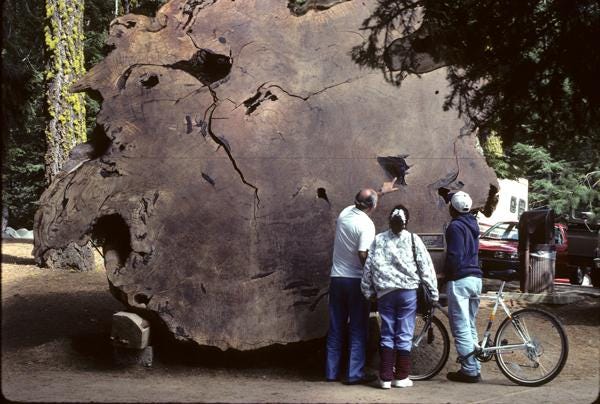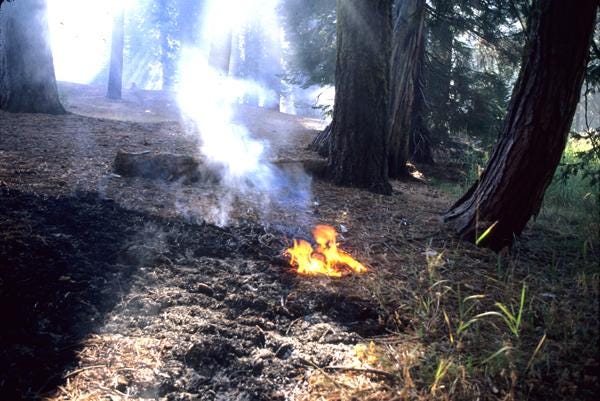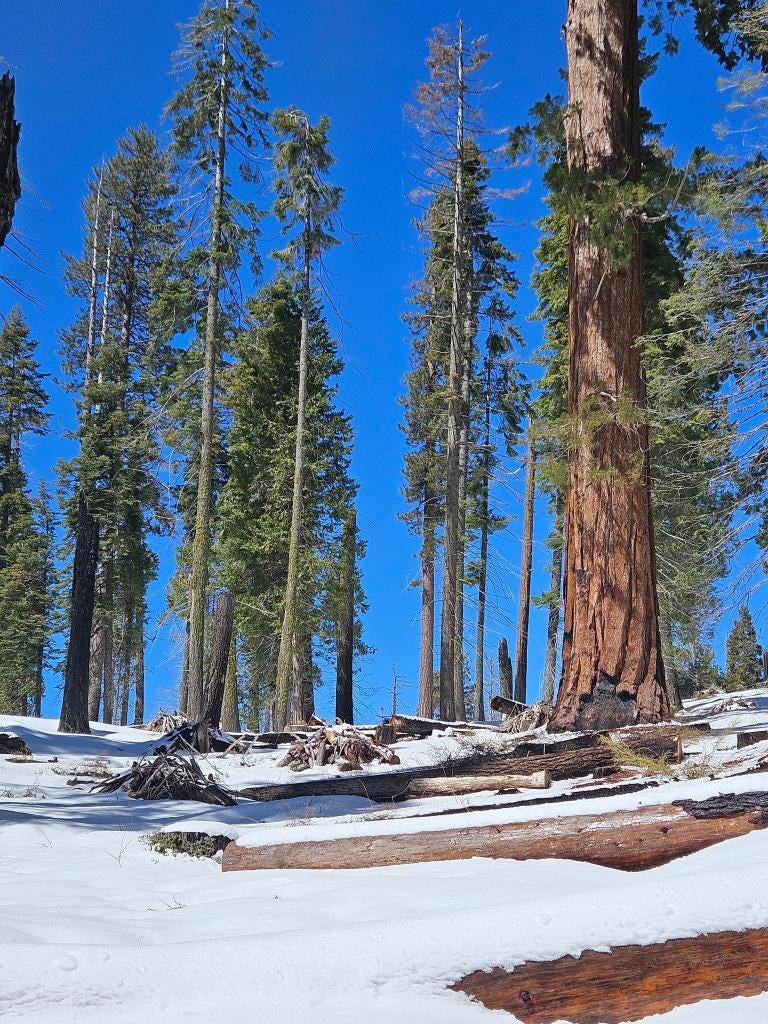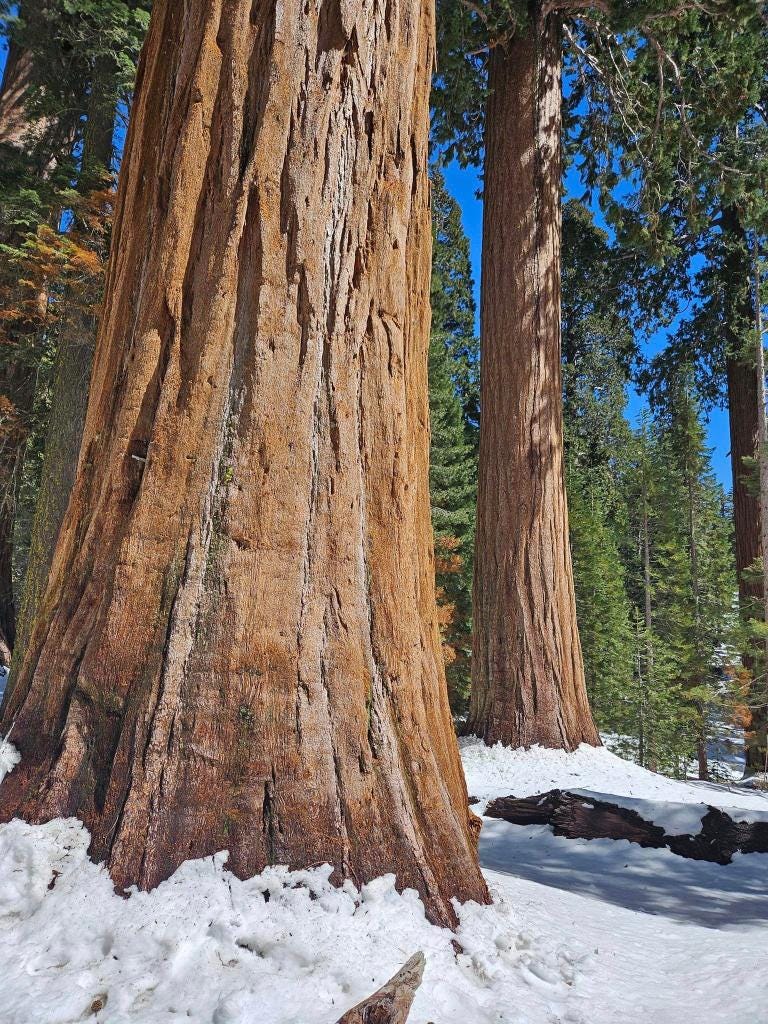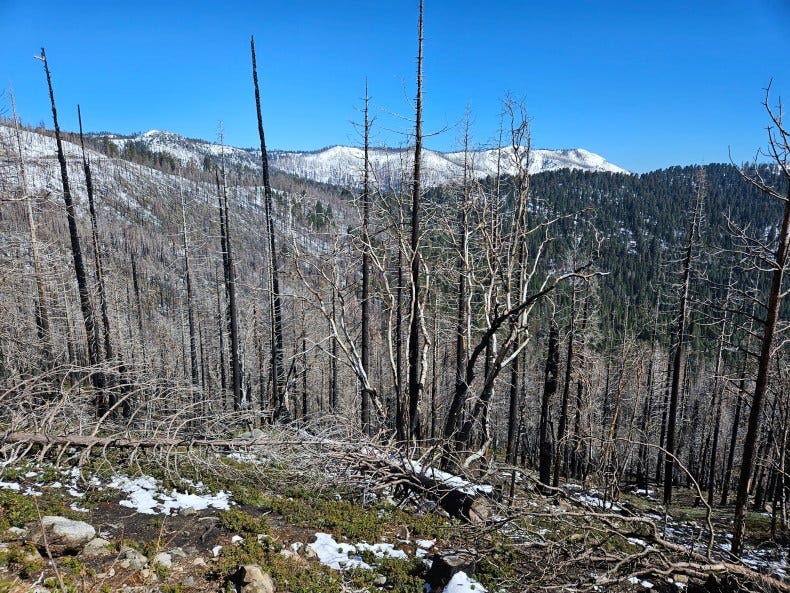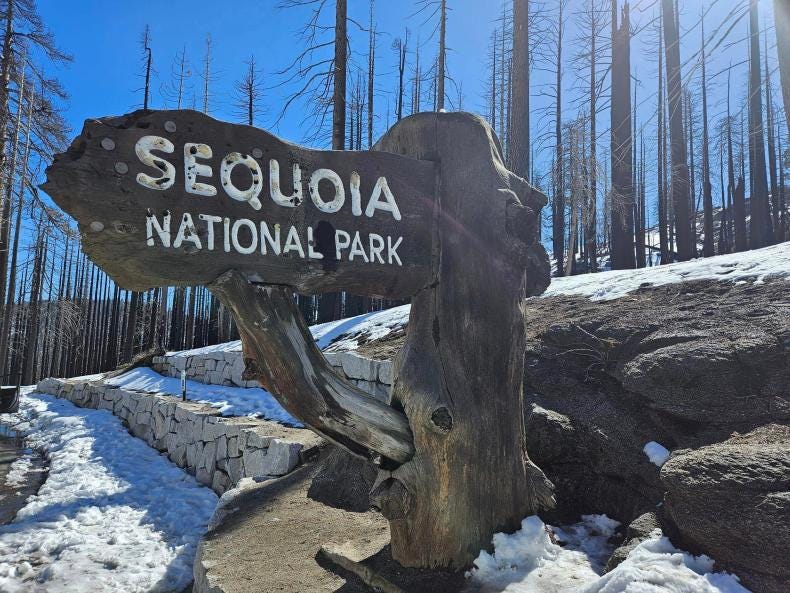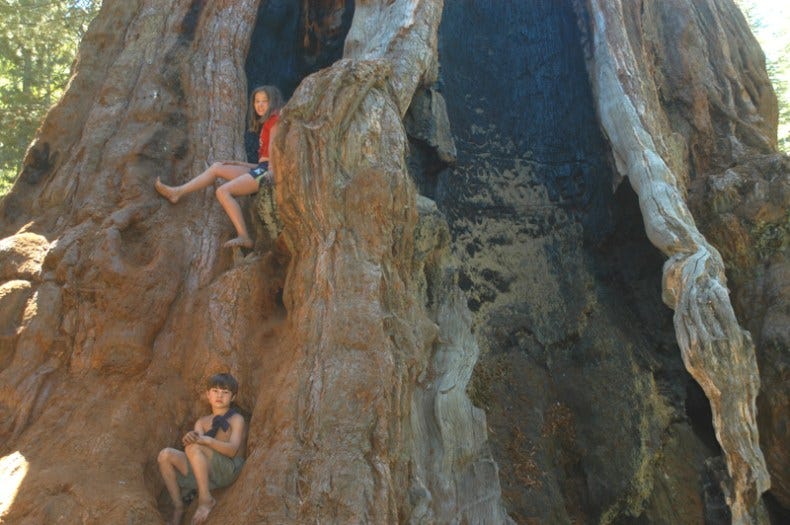Human Intervention Not Necessary For Sequoia Survival
Federal agencies alarmed by large fires promote tree planting and other unneeded measures in sequoia groves for successful regeneration.
Giant Sequoia May Require High-severity Blazes for their surival. Photo George Wuerthner
During the summer of 2020 and 2021, with one of the most severe droughts in California’s recent history, wildfires charred thousands of acres in the Sierra Nevada. Some of the mountain range’s magnificent sequoia groves were among the areas burned.
I recently visited Kings Canyon-Sequoia National Park and Giant Sequoia National Monument to observe firsthand the wonderful natural effects of high-severity blazes among sequoia groves. Standing among blackened trunks in Sequoia National Park, I was surrounded by air filled with woodpeckers hammering away at charred boles. The open sunlight of the snag forest permitted extensive vistas of the mountain stronghold of these trees. As many ecologists have increasingly come to conclude, high-severity blazes and the resultant snag forests are essential to healthy functioning ecosystems.
However, looking at acres of burned trees, I could understand why some people are disheartened and dismayed by the loss of centuries-old trees. A seedling is no replacement for a giant with a circumference of 100 feet or more.
This raises the question of whether our parks should be managed as “museum pieces” or if managers should encourage evolutionary and ecological processes to prevail. In terms of sequoia regeneration, it appears that high-severity blazes are critical to the successful regeneration of the species across landscape scales.
In the aftermath of recent fires, as many as 20% of giant-sequoias-wildfires were killed, setting alarms that high-severity blazes may threaten sequoia forests.
Cross section of giant sequoia records past fires as “scars”. Photo George Wuerthner
According to some authorities, Indian burning at frequent intervals kept fuels low in sequoia stands, and wildfires were moderate and seldom killed mature trees. They conclude that fire suppression has permitted fuels to build, and the resulting wildfires are more severe and kill the mature trees. However, some fire experts question these assertions.
Prescribed burn in Grant Grove, Kings Canyon Sequoia NP, CA is designed to remove small trees and other fuels. Photo George Wuerthner
However, it is important to note that the NPS was the first agency to recognize the importance of wildfires as an evolutionary agent in forests. Beginning in the 1960s and early 1970s, the National Park Service began prescribed burning or intentionally set fires in sequoia groves in Yosemite and Kings Canyon-Sequoia National Park to reduce fuel build up.
The general theme was that low to medium-severity wildfires (in which mature trees could survive) were the norm, with only an occasional small area burned by high severity. The 2020-2021 wildfire fires, which killed many trees, seemed outside the historical norms for sequoia groves.
Federal legislation known as the “Save Our Sequoias Act” has been introduced to increase burning and logging in sequoia groves to “restore” them to their “natural” condition.
However, not all fire ecologists agree with these interpretations of sequoia ecology, which led to a controversy over what should be done in the aftermath of these fires—including whether the National Park Service should intervene in the regeneration process by planting sequoia seedlings in designated wilderness areas where natural processes are supposed to be maintained.
There has been debate about the historic fire regimes in the dry forests of the Sierra Nevada for some time. Some researchers argue that occasional high-severity blazes were part of them.
Three environmental groups are partly suing the National Park Service to prevent human seedling establishment in designated wilderness areas.
Stump of a petrified redwood tree in Yellowstone National Park. Photo George Wuerthner
Sequoia trees (Sequoiadendron giganteum) and the taller redwoods (Sequoia sempervirens) found along California coasts are relics of past climates. At one time, both species were far more widespread. Indeed, 50-million-year-old petrified redwoods were found on Specimen Ridge in Yellowstone National Park.
Forest thinned by the NPS in Grant Grove Kings Canyon National Park. Photo George Wuerthner
Sequoia are relegated to 70 groves of varying sizes located on the western slope of the Sierra Nevada. Most sequoia stands are in Kings Canyon-Seqouia National Park, Yosemite National Park, and Giant Sequoia National Monument. However, a few other groves are found within state parks, on other Forest Service lands, and on the Tule River Indian Reservation.
Sequoia are adapted to wildfire. Their bark, up to two feet thick, protects the tree from the heat of fires. The mature trees “self-prune,” losing lower branches that might otherwise allow a wildfire to climb or “ladder” into the crown. And perhaps most importantly for this discussion, sequoia cones tend to remain closed until heated, when seeds are released.
Giant sequioa groves are only found on the western slope of the Sierra Nevada between 5000-8000 feet. Photo George Wuerthner
The dispute arises over the role of high-severity fire in sequoia ecology. Some scientists contest that sequoia regeneration has been inhibited due to a lack of high-severity fire. While low or moderate fire may clear away brush and small trees, these scientists contend that high-severity fire stimulates massive seed release and seedling survival, essential to long-term sequoia survival. The irony is that the giant 2000-year-old trees we love may have resulted from earlier massive blazes.
There is some evidence that a previous major drought known as the Medieval Warm Spell (800-1300 AD) spawned numerous large wildfires across the western slope of the Sierra Nevada. Although the study’s authors presumed that most of these fires were small, low intensity (the majority of all wildfires), there is no doubt that the occasional large, high-severity blazes may have led to the creation of many of the large tree groves that now are protected within federal and state parks.
The Redwood Mountain area that burned at high-severity, but where seedling regeneration was high. Photo George Wuerthner
Research by the National Park Service confirms a massive regeneration failure among sequoia groves. Rather than harming sequoia groves, high-severity fire may be essential for their long-term survival.
Evolutionary evidence suggests sequoia trees may require high-severity blazes for successful reproduction. The cones of sequoia trees are serotinous, which means they tend to remain closed and remain viable often for years until a significant wildfire heats them and cones are released.
The high-severity blazes also prepare the ground for the successful survival of seedlings by temporarily removing the competing vegetation.
Finally, sequoia are among the fastest-growing trees in the West. A three-year seedling may easily reach 8 or 9 feet in height, allowing it to grow above competing plants and dominate the forest canopy.
In 2021 wildfire burned through the Redwood Mountain portion of Sequoia National Park. Photo George Wuerthner
In a recent paper, “Reproduction of a Serotinous Conifer, the Giant Sequoia, in a Large High Severity Fire Area,” the researchers found that “giant sequoia seedlings are more dominant relative to other conifer species and are growing faster in a large high-severity fire area than in adjacent low/moderate-severity areas.”
The researchers evaluated seedling establishment and survival resulting from the 2021 KNP Complex fire in the Redwood Mountain Area of Kings Canyon-Sequoia National Park.
The authors conclude: “Our results call into question the basis for widespread plans and projects designed to prevent high-severity fires and should reevaluate moving forward with proposed tree planting activities in high-severity fire areas within giant sequoia groves.”
Like others in recent years, these findings challenge the standard narrative that Indian burning and fire suppression maintained “healthy forest ecosystems.”
While evidence suggests that Indian burning in the Yosemite Valley may have led to localized shorter fire rotations, on a landscape scale, climate was the driving force in wildfire and tended to result in much longer fire intervals. Photo George Wuerthner
For instance, a recent study of Yosemite National Park found that while frequent low-severity fires were common in the Yosemite Valley, where Indian villages were located, overall, the majority of all wildfires in what is now Yosemite were a consequence of climate.
As with numerous other studies, the idea that Indian burning maintained “healthy forest ecosystems” may be overgeneralized. Most human ignitions were localized. Plus, the fact that sequoias have existed for at least 50 million years and humans only colonized North America 15,000 or so years ago suggests that sequoias (and redwoods) thrive without human interventions.
The authors of the Yosemite study concluded: “We analyzed charcoal preserved in lake sediments from Yosemite National Park and spanning the last 1400 years to reconstruct local and regional areas burned. Warm and dry climates promoted burning at both local and regional scales….”
The researchers say:” Regional area burned peaked during the Medieval Climate Anomaly and declined during the last millennium, as the climate became cooler and wetter and Native American burning declined.”
They concluded with: “Our record indicates that (1) climate changes influenced burning at all spatial scales, (2) Native American influences appear to have been limited to local scales, but (3) high Miwok populations resulted in fire even during periods of climate conditions unfavorable to fires. However, at the regional scale (< 150 km from the lake), fire was generally controlled by the top-down influence of climate.”
Earlier, geographer Thomas Vale reached similar conclusions about fire in Yosemite and Sierra Nevada.
Most of us would undoubtedly want to protect to the degree possible some of the most extensive and outstanding representatives of these magnificent trees; however, over the long run, human intervention may not be necessary and may even inhibit the long-term survival of the sequoia.




